American Goldfinch: Field Guide, Pictures, Habitat & Info
Last Updated on
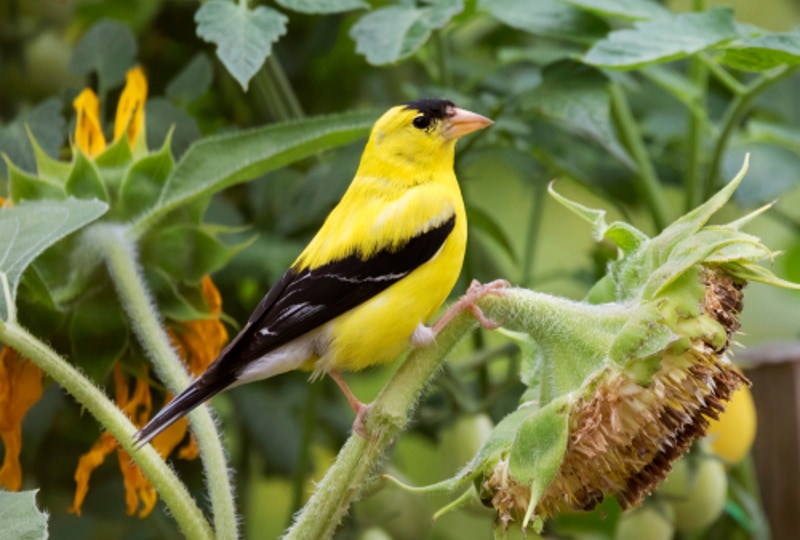
American goldfinches (Spinus tristis) are active and acrobatic members of the finch family that often fly in a bouncy and wavy pattern. Occasionally, the American goldfinch is referred to as the “Wild Canary” due to its unmistakable yellow plumage. Finding one of these beautiful birds in your backyard isn’t difficult, as they often call in flight to draw attention to themselves. Keep reading to learn more about this favorite species among birdwatchers so you can attract this sunny fellow to your backyard.

Quick Facts About the American Goldfinch
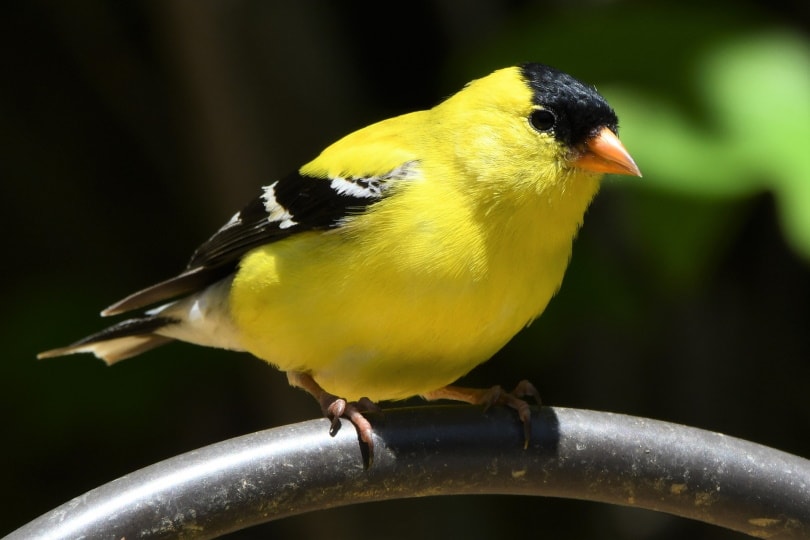
| Habitat | Open woodlands |
| Diet | Seeds |
| Behavior | Foliage-gleaner |
| Nesting | Shrub |
| Conservation | Low Concern |
| Scientific name | Spinus tristis |
| Lifespan | 10 years |
General Description
The American goldfinch (Spinus tristis) is characterized by a conical bill, flashy white wing bars, and a pointed, notched tail. By far, their most identifiable characteristic is their bright yellow plumage, which is highlighted by a deep black forehead and wings. The breeding males are extremely bright in color when compared to the females, which are pale brown with tinges of light yellow or olive on the face.
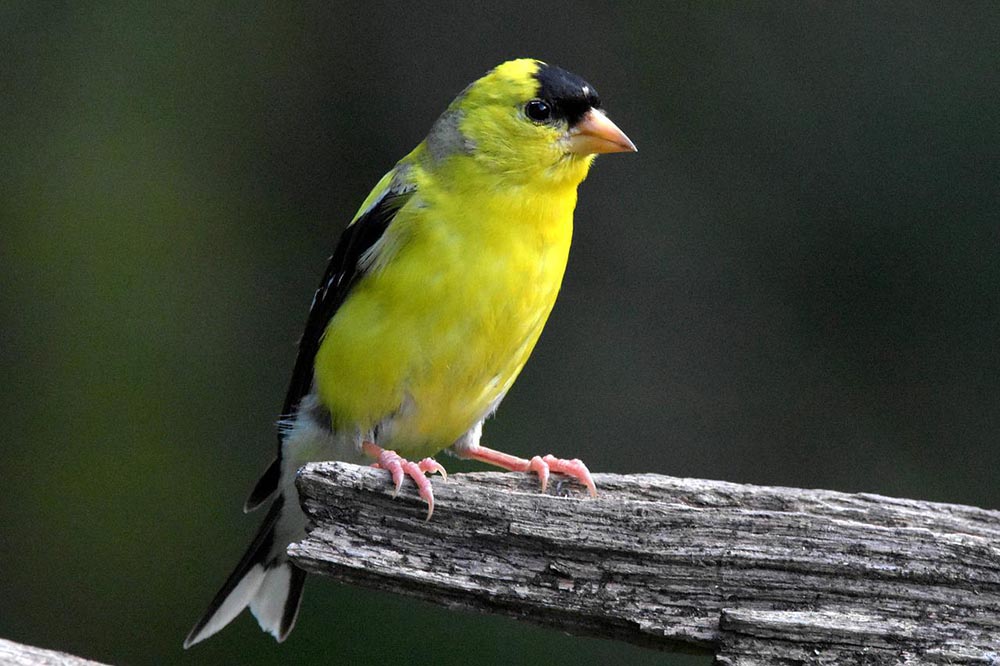
Range, Habitat, Behavior, Diet, & Nesting
Range
American goldfinches are common throughout most of North America. Breeding birds spend much of their time in the continent’s northern reaches while nonbreeding birds tend to stay in southern areas. They can virtually be found anywhere in open country where thistle and other seeded plants are abundant.
Habitat
American goldfinches are most commonly found in weed-dense fields and floodplains, although they are also found along roadsides, open woods, orchards, streamsides, backyards, and suburban areas of North America. In the wintertime, American goldfinches are often found in open fields and around backyard feeders. These colorful birds are relatively widespread, and you can look for them where plants such as thistles and asters are common.
Behavior
American goldfinches fly in a bouncy, undulating pattern with alternating phases of flapping and gliding. They often make a characteristic “po-ta-to-chip” call during flight, which can easily draw your attention to them. These small songbirds are highly acrobatic and can often be found hanging or precariously balancing on top of flowers, seedheads, and grasses. Oftentimes, American goldfinches will forage in flocks; however, they forage alone during the breeding season.

Diet
American goldfinches generally forage in flocks outside of the breeding season. Usually, they gather food in weeds, shrubs, and trees, where they are found dangling from branches to reach certain seeds. The American goldfinch diet is primarily made up of seeds, weeds, and grasses. The young seeds of daisies, elms, birches, and alders are preferred, although buds, bark, and maple sap are common treats as well. Young nestlings are fed regurgitated seed material, and insects are very rarely consumed as a summertime supplement. American goldfinches acquire their signature yellow plumage through their diet, which is full of carotenoid pigments.
Nesting
After the American goldfinch chooses its mate, the pair moves around together, looking for a suitable nesting site. The female usually builds the nest in tall shrubs suspended by several branches and shaded by leaves. The female weaves the nest by building a foundation of spider silk, on top of which she aligns rootlets and plant fibers into a cup-like shape. The nest is then lined with plant-down to make a soft and fluffy bed for the eggs. Interestingly, the nest is woven tight enough to hold water and is generally 3 inches in diameter and 2 to 4.5 inches high.
After the nest is built, the female will lay a clutch of two to seven pale blue eggs with faint brown spotting. She then incubates the eggs for 12 to 14 days, during which the male forages for food and feeds her. After the eggs hatch, both parents feed the nestlings, with the male assuming most of the responsibility as the young get older. After 11-17 days, the young leave the nest, and the pair may raise another brood.
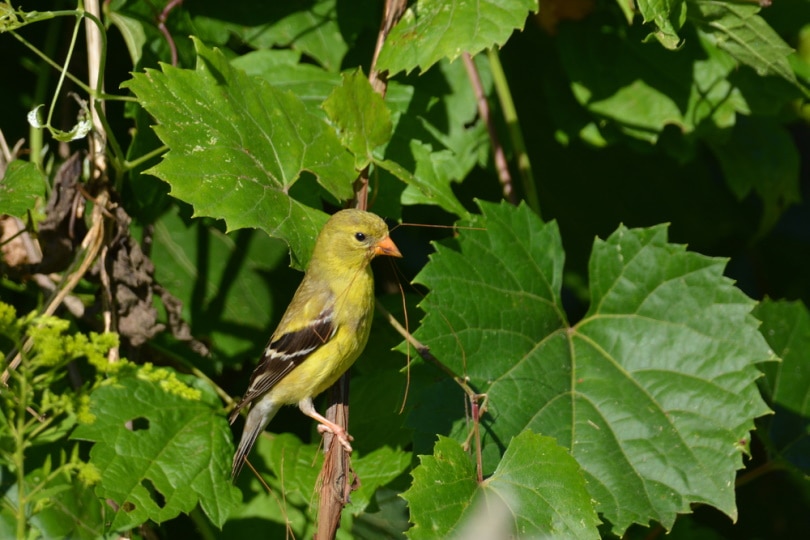
How to Find the American Goldfinch: Birdwatching Tips
What to Listen For
Before taking flight, American goldfinches sing a distinctive four-syllable call that sounds like “po-ta-to-chip.” During courtship, males will often make a “tee-yee” call when landing near a female. Otherwise, they sing a long and variable song filled with twitters and warbles in seemingly random order. However, these songs are not actually random and are learned patterns that are acquired through the bird’s lifetime. Interestingly, American goldfinches make identical calls to their mates when in their breeding pairs. This is thought to help other flock members distinguish between pairs of goldfinches.
What to Look For
American goldfinches prefer backyards with open, grassy fields full of plants and weeds. Since the birds eat a diet almost exclusively of seeds, look for collections of plants and flowers with many seeds, such as thistles, cattails, cottonwood fluff, daisies, and milkweed. If running water is nearby, you have a high chance of spotting one of the bright birds.
When to Look
American goldfinches frequent bird feeders all year long. However, they are most commonly seen in the winter when plant matter is scarce. Unlike most North American birds, American goldfinches breed much later, often nesting in June or July when seedy plants are abundant. During this time, look for them gathering fibrous seeds and plant matter to build their nests.
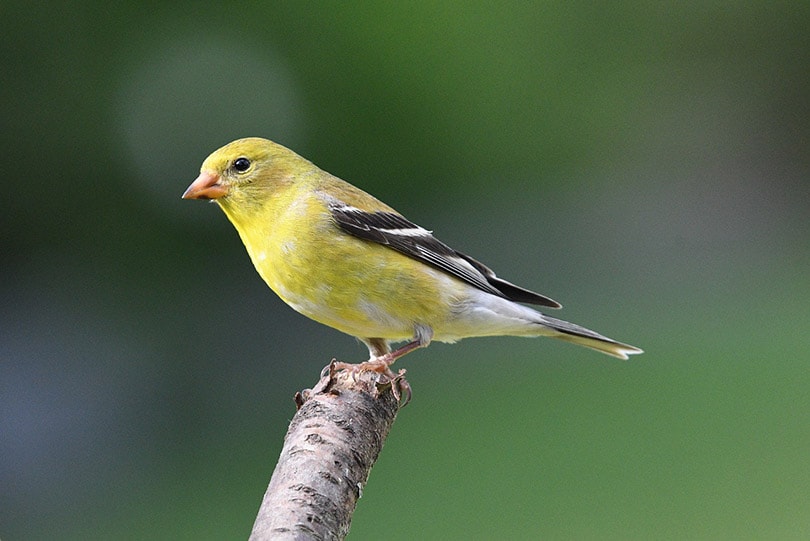
Attracting American Goldfinches to Your Backyard: Tips & Tricks
- To encourage American goldfinches to visit your backyard, be sure to plant native plants such as thistles and milkweed. They also like grassy plants like cottonwood fluff and cattails.
- American goldfinches do not have a preference for any one type of bird feeder, so anything from a hopper, platform, ground, or swinging feeder will attract them to your property.
- Some of the American goldfinch’s favorite snacks include sunflower seeds and nyjer, so including these treats is sure to send these sunny avian fellows your way.
- Keep the ground well raked and your birdfeeders clean to protect American goldfinches from contagious diseases.
- American goldfinches prefer clean and fresh food, so replacing your bird seed every three to four weeks will ensure they keep coming back.
- American goldfinches love running water, especially in winter, as it doesn’t freeze. Installing a birdbath with a fountain is sure to make your backyard a hot spot for goldfinches.

American Goldfinch Conservation: Is This Bird Threatened?
American goldfinches are common birds in North America’s backyards and are a species of low conservation concern. A global breeding population of approximately 44 million birds is estimated by the Bird Conservancy of the Rockies, with a total population decline of roughly 27% since 1966. American goldfinches score a 6 out of 20 for continental concern by SONAB’s (State of North American Birds) report, which is based on data such as population size, vulnerability, threats, and population distribution.

Conclusion
The American goldfinch is a fascinating sight and a welcome visitor at backyard feeders all across North America. With their unique and unmistakable flight call and sunny plumage, it is easy to see why the American goldfinch is a favorite amongst birdwatchers. We hope that you’ve learned some new things about goldfinches by reading this article. Next time you’re observing the birds in your neighborhood, try listening for the American goldfinch’s “po-ta-to-chip” call and see if you can spot one!
Featured Image Credit: Natalia Kuzmina, Shutterstock
Table of Contents
About the Author Laura Guziczek
Laura Guziczek is from New York City and an aerospace engineer by day, freelance writer by night. Although she is always moving around, Laura is currently based on Florida's sunny Space Coast, where she attends graduate school. Her passions and hobbies include astrodynamics, rocketry, spaceflight, planetary science, cooking, music, and art, making her a great fit here at OpticsMag! When she's not working, you can frequently find her traveling, honing her cooking skills, thinking about space too much, and hanging out with her friends and dogs.
Related Articles:
10 Types of Hummingbirds in Arkansas (With Pictures)
8 Types of Hummingbirds in Nebraska (With Pictures)
5 Types of Hummingbirds in Idaho (With Pictures)
3 Types of Hummingbirds in Mississippi (With Pictures)
8 Types of Hummingbirds in Kansas (With Pictures)
5 Types of Hummingbirds in West Virginia (With Pictures)
5 Types of Hummingbirds in Ohio (With Pictures)
Where Do Nuthatches Nest? Nuthatch Nesting Habits Explained
